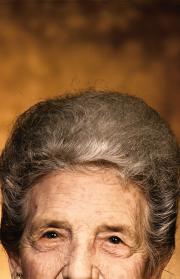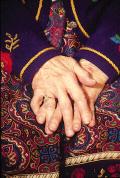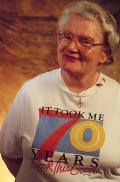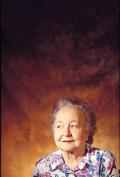 |
| photograph by Gene Bednarek |
Senior Boom
By Michael Podolsky
The year was 1951 and the first baby boomers were entering kindergarten. At the University of Florida, preparations were already under way for their retirement.
The new field of gerontology, the study of adult aging, was just developing and UF quickly took a lead role. Longer lifespans and booming birthrates assured the long-term need for an understanding of the dynamics of becoming older.
As the baby boomers entered high school, college and eventually adulthood, UF's study of how they would spend their twilight years grew as well. New projects and professors concentrated on all aspects of what older Americans needed, wanted and had.
 |
 |
 |
 |
 |
 |
 |
 |
 |
Circumstances have left UF uniquely positioned to focus on gerontological issues. As Florida's older population has exploded with retirees, the state has become a bellwether of what will eventually happen to the nation.
And now, as those children of the 50s begin to contemplate retirement, UF is consolidating all of its gerontological studies under one umbrella, the Institute for Gerontology. More than 160 faculty have more than $20 million in external funding to research the effects, implications and dynamics of aging. Research ranges from housing options to nutrition to examinations of how aging affects creativity, memory and cognition, including work on Alzheimer's disease.
Heading UF's new, centralized efforts to comprehend what happens to the human body and mind as they age is Raymond Coward, director of the institute.
``We've had gerontological studies on campus since 1951, but we've never had them under one umbrella organization until now,'' Coward says. ``We're tying together the diversity of the work that is being done on the UF campus.''
The timing of this consolidation could not be better. Florida today is where the rest of the nation will likely be in 2025, according to demographers, with about 18.4 percent of its citizens over the age of 65.
``Policy makers in other states are looking to Florida and asking how we deal with issues they are going to face in 10 years,'' Coward says.
``The 65-and-older population is the fastest-growing demographic in the country. The number of elders we will have in the next 20 years is unprecedented,'' Coward continues. ``Not only are we reaching 65 in larger numbers, but we are living longer as well.''
According to the U.S. Census, 12.8 percent of the population in 1994 was more than 65 years old, but by 2010 that figure is expected to be 13.4 percent, and by 2025, 18.4 percent, or 62 million people, are expected to be older than 65.
The increasing numbers of elders pose unique questions for the country: How will we provide health care for our elders? How will we treat new forms of disease striking older Americans? Where will the booming elderly population, some of whom will have special medical needs, live?
Health care is a special concern for elders. Although elders currently comprise 13 percent of the population, they account for one third of all the money spent on health care.
Medicare was created to ensure that elders received the health care they needed, Coward says, but the elderly population has grown so fast that our ability to pay for that care has diminished. Another approach has focused on researching ways to improve the health of the elderly, and thereby decrease the cost of treating them.
At UF, the National Institutes of Health has given the College of Pharmacy $7 million to study Alzheimer's disease. Pharmacodynamics Professor James Simpkins heads a team of researchers charting new territory in the study of the debilitating disease.
Based on data that showed that fewer post-menopausal women who were receiving estrogen replacement therapy contracted Alzheimer's, Simpkins set out to determine if estrogen therapy provided some kind of protection against Alzheimer's.
``Somehow, the estrogen protects the nerve cell from the type of damage that we see in Alzheimer's patients,'' Simpkins says. ``It's very exciting because we can actually offer some treatment for the disease itself, rather than just the symptoms.''
Simpkins believes estrogen's protective qualities may partially lie in its ability to prevent calcium from getting into damaged nerve cells.
``Calcium is usually kept out of cells, but when a cell is sick or damaged, calcium rushes in and the cell will die,'' he says. ``Estrogen somehow reduces that calcium influx.''
Simpkins' research team has found that the properties in estrogen that afford the cell protection are not linked to the feminizing properties of the hormone, so estrogen treatment can be effective in men as well as women.
Alzheimer's disease is difficult to research because by the time it is detected, up to 70 percent of the nerve cells in the patient's brain have already been affected, Simpkins says.
``If we had some early markers, then we might be able to get people on therapy,'' he says. ``But now, it doesn't even show up until it's almost too late.''
Researchers have discovered that most Alzheimer's patients have neurofibulary tangles in their nerve cells. These tangles are knots in the microscopic tubes that allow nerve cells to issue commands. These tangles can affect muscle control, as well as memory and behavior. Simpkins and his team are also conducting research into what causes the tangles and what can affect them.
Networking Care
While Simpkins studies the health of the brain, Eleanor Palo Stoller is trying to understand how older people deal socially with frailty. In a three-year, $600,000 National Institutes of Health project, Stoller is studying a group of aging members of a Finnish community in South Florida to determine the relationship ethnicity has on support networks.
``I'm trying to find out how people establish a support network as they age and cope with the early stages of disability and the onset of frailty,'' says Stoller, a professor in the Department of Health Policy and Epidemiology. ``These are people who may need more than help around the house, but are not in need of hospital or nursing home care.''
She says she is fortunate to have a tightly knit group of Finnish-Americans to study. The Finns began retiring to the Lake Worth/Lantana area in the late 1940s and early 1950s. While the original settlers have died, younger retirees with the same ethnic background have replaced them.
``We are trying to determine whether people consider ethnicity when they seek support,'' Stoller says. ``In particular, we're interested in whether relationships with people of the same ethnic background resemble kinship relationships more than mere friendships.''
Stoller's research focuses on the first stages of health problems for the elderly. Her subjects are just beginning to need medical help, and she is keenly watching how they handle this new component of their lives.
``We're finding that, at first, people tend to depend on both friends and family for help,'' she says. ``But later on, when the medical needs become greater, the friends tend to drop out.
``This is where the ethnicity question emerges,'' Stoller continues. ``We are interested in learning whether friends who have the same ethnic background provide help at higher levels of disability and if they are slower to drop out.''
Another aspect of Stoller's research focuses on how people treat themselves as health problems arise. In a study she conducted while a faculty member at the State University of New York, Stoller asked a group of older people to keep health diaries, in which they recorded health problems, whom they contacted for help, what treatments they used and if they were effective.
``The research suggests that up to 80 percent of symptoms are treated outside the formal medical-care system,'' she says. ``People don't go to the doctor all the time if they have what they perceive to be minor symptoms. Instead, they'll try to cure themselves, using home remedies or the like.
``Many older people have chronic diseases,'' she continues, ``and over time they often develop considerable expertise in managing these conditions.''
The vast majority of people in the study described home treatments that a panel of clinicians rated as therapeutic or palliative. The majority, however, also mentioned treatments that were conditionally harmful, meaning they could be harmful if used incorrectly, excessively or in combination with other medications.
Home Sweet Home
In the geography department at UF's College of Liberal Arts and Sciences, Professor Stephen Golant is studying the housing needs of elderly people, factoring in economic, social, medical and family situations.
In the past, elders had two choices when they became frail or needed assistance. They could have family members care for them or they could move into a nursing home. Very few could afford home medical-staff care.
Golant is studying a third possibility, a relatively new concept called assisted living facilities, or ALFs.
``Assisted living facilities are more like a hotel, while a nursing home is more like a hospital,'' says Golant, author of Housing America's Elderly. ``For a large segment of the elder population this is a viable option.''
While elders may occasionally need special medical services, many are not yet ready for the medically intensive environment of a nursing home, Golant says. ALFs are less expensive to run than nursing homes and should be subject to less government oversight, Golant says. This would make them affordable to many elderly who could not afford nursing homes.
``An assisted living facility offers an elder a secure environment, while at the same time offering them as much independence as possible,'' Golant says. ``It's a happy medium.''
However, Golant fears ALFs will get caught up in the increasing battle over funding elderly programs and health-care reform.
``You don't want to swamp them with regulations, the way nursing homes are,'' he says. ``It's very expensive to meet those stringent government regulations and that might just put them out of the reach of people who need them. They have tremendous potential.''
Wisdom Of The Ages
While Golant studies the living situation of elders, Anne Wyatt-Brown, in UF's linguistics program, focuses on their minds, particularly those of writers as they age.
Wyatt-Brown has studied the writing of authors as they age and found that many will take on topics they avoided during younger days.
``Many times, they will go back and take up issues that have been buried during their lives,'' she says. ``They take care of unfinished business.''
Older writers also tend to experiment more, she says.
``Styles can change dramatically with age,'' she adds. ``At the time, the experimentation is often not understood. It is only later that it is appreciated.''
Aging writers also mellow a bit.
``As writers age, their writings reflect that they are often more tolerant, more accepting of the way things are in life,'' Wyatt-Brown says.
And their writings often become more complex.
``They stop trying to give easy answers and deal with complicated issues,'' she says. ``They have a sense of mission. Older people want to leave something for the next generation, they want to pass on their knowledge and life experience.''
Raymond T. Coward
Director, Institute for Gerontology
(352) 395-8036
rtc@hpe.ufl.edu
Stephen M. Golant
Professor, Department of Geography
(352) 392-0494
golant@geog.ufl.edu
James Simpkins
Co-Director, Center for Neurobiology of Aging
(352) 392-8509
simpkins@cop.health.ufl.edu
Eleanor Palo Stoller
Professor, Department of Health Policy and Epidemiology
(352) 395-0680
estoller@hpe.ufl.edu
Anne Wyatt-Brown
Assistant Professor, Linguistics Program
(352) 392-0639
amwb@lin.ufl.edu